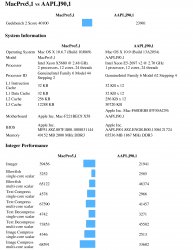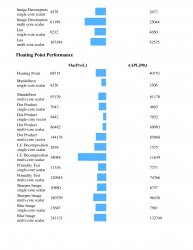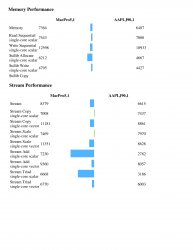GPU Performance Update/Analysis No.1
Over the course of the last few months, I've performed a number of benchmark tests with my CUDA Rigs involving their OpenCL performance with Luxmark and their CUDA performance with AfterEffects ("AE") and Octane Render:
(1) See, e.g, posts #s 33 - 40 [ https://forums.macrumors.com/threads/1587574/ ];
(2) See, e.g, post #8 [ https://forums.macrumors.com/showthread.php?p=17607424#post17607424 ].
Some of the conclusions that I've drawn are as follows:
(1) In at least one of the OpenCL only benchmarks (Luxmark), your GTX card(s)'s performance will be lower than that of comparably priced ATI video cards. The reason for this may be as 666sheep suggests in post no. 607 in this thread [ https://forums.macrumors.com/threads/1333421/ ], namely that the code was not optimized for Nvidia cards.
(2) In CUDA benchmarks, your GTX cards may exhibit linear performance gains with additional GPUs of the same type (like in Octane render) and your GTX cards may not exhibit linear performance gains with additional GPUs of the same type (like in AE). E.g., one of my Titan's performance of that AE CUDA test used by Barefeats, was completed in 9 min. 16 secs (faster than test run with 3 GTX 580 Classified) and in the After Effects CS6 CUDA Benchmark Test linked to here [ https://forums.macrumors.com/threads/1587574/ ], one Titan card completed the test in 3 min. 43 secs and two Titan cards completed the test in 2 min. 55 secs, but any number of cards >2 took longer to complete the test than one Titan card did.
(3) Currently the king of GTX CUDA performance is the GTX Titan.
(4) Be guided in your GPGPU selection by the software you will run on it.
Over the course of the last few months, I've performed a number of benchmark tests with my CUDA Rigs involving their OpenCL performance with Luxmark and their CUDA performance with AfterEffects ("AE") and Octane Render:
(1) See, e.g, posts #s 33 - 40 [ https://forums.macrumors.com/threads/1587574/ ];
(2) See, e.g, post #8 [ https://forums.macrumors.com/showthread.php?p=17607424#post17607424 ].
Some of the conclusions that I've drawn are as follows:
(1) In at least one of the OpenCL only benchmarks (Luxmark), your GTX card(s)'s performance will be lower than that of comparably priced ATI video cards. The reason for this may be as 666sheep suggests in post no. 607 in this thread [ https://forums.macrumors.com/threads/1333421/ ], namely that the code was not optimized for Nvidia cards.
(2) In CUDA benchmarks, your GTX cards may exhibit linear performance gains with additional GPUs of the same type (like in Octane render) and your GTX cards may not exhibit linear performance gains with additional GPUs of the same type (like in AE). E.g., one of my Titan's performance of that AE CUDA test used by Barefeats, was completed in 9 min. 16 secs (faster than test run with 3 GTX 580 Classified) and in the After Effects CS6 CUDA Benchmark Test linked to here [ https://forums.macrumors.com/threads/1587574/ ], one Titan card completed the test in 3 min. 43 secs and two Titan cards completed the test in 2 min. 55 secs, but any number of cards >2 took longer to complete the test than one Titan card did.
(3) Currently the king of GTX CUDA performance is the GTX Titan.
(4) Be guided in your GPGPU selection by the software you will run on it.
Last edited:




